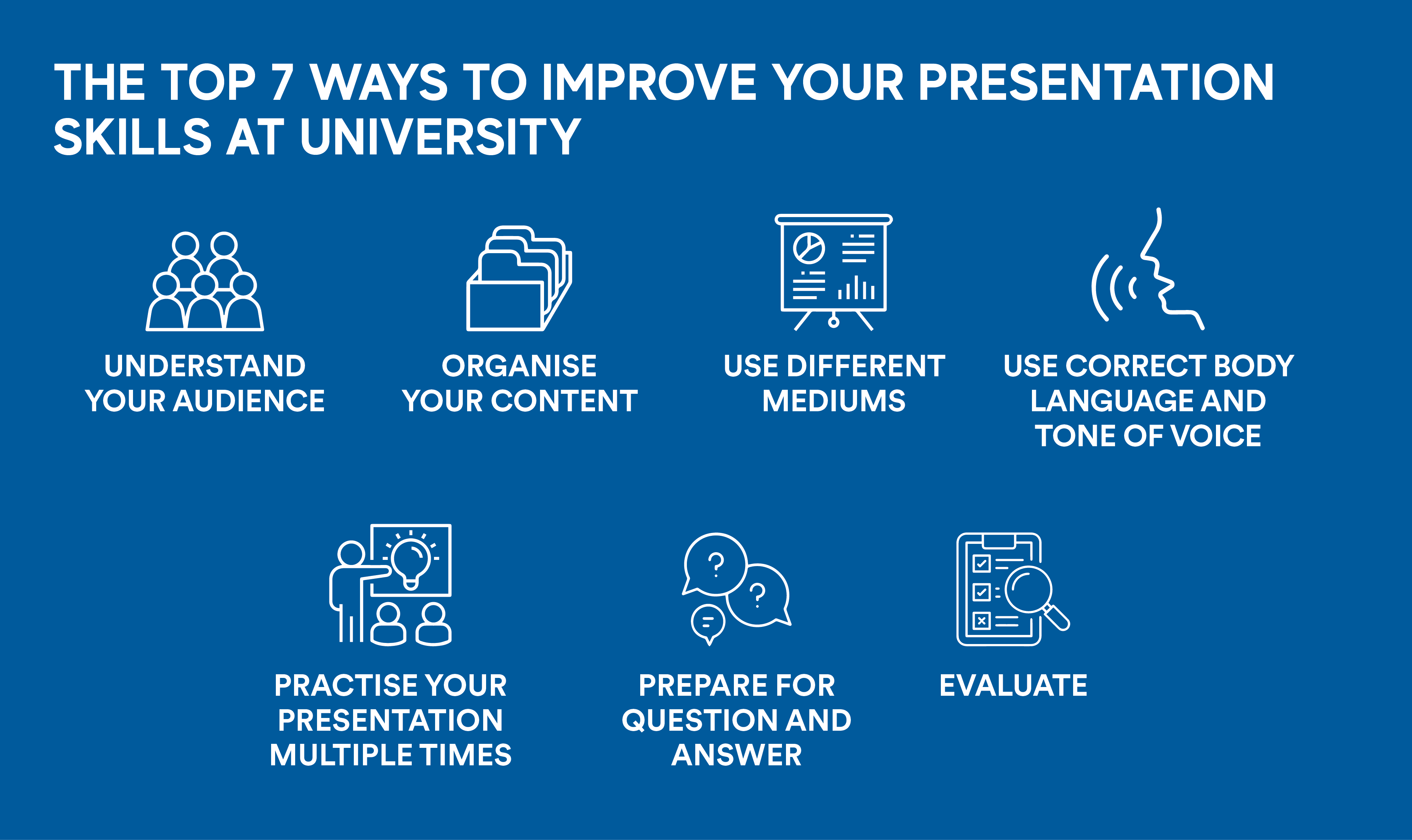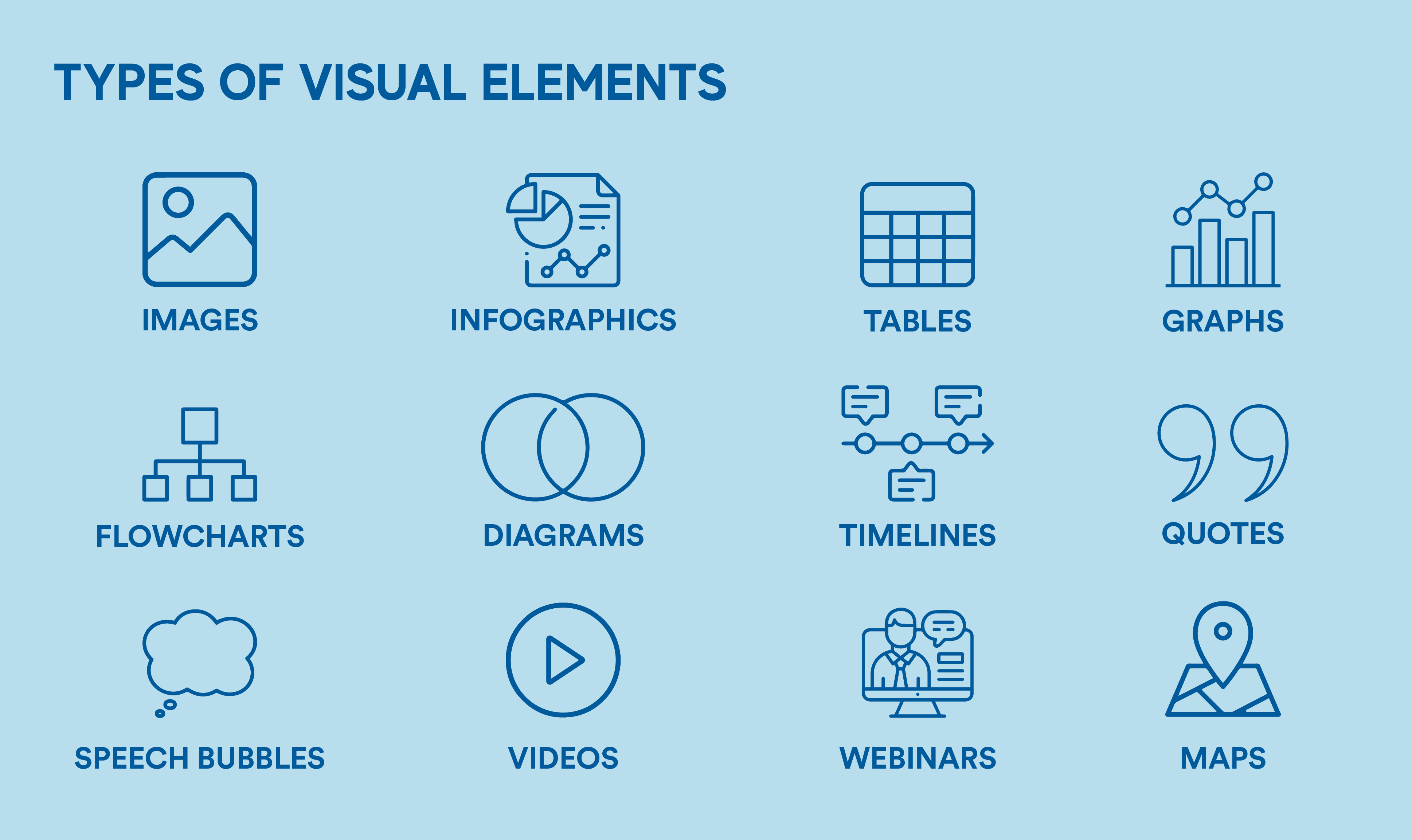
Being able to present your ideas clearly in front of people is an essential skill, applicable to every stage in your life, from high school to university to work. Presenting your ideas can happen at any time of the day such as during a study session with your classmates, or in front of your class as part of an assessment. The way you present affects your academic results at university and job opportunities when you begin your career.
In this blog, we will explain the top 7 ways on how you can improve your presentation skills at university.

1. Understand your audience
Before you start writing down ideas or developing slides, research your audience. Understand their interests, needs and goals to know what topics will engage them. For example, if you are asked to present on a Marketing topic, you could talk about social media trends or influencer marketing since it is largely present in the lives of younger people.
Learn how your fellow students consume content. For example, if you are presenting to international students, English may be their second language so use simpler language, less text on the slides and more visual elements such as graphs, infographics or videos.
Your assessment task will give you a general idea of what you need to present, but it is your audience that will determine specific topics and how you present that information.
2. Organise your content
Your presentation needs a clear structure and flow. Organised content provides clarity of your message. Follow these steps:
- Look at each question of your assessment task and write down all the ideas, findings and recommendations.
- Identify key points for each section – these will be your headings.
- Group related information under sub-headings.
- Select the best presentation structures to use such as ‘problem-solution’ (highlight an issue then present your solution) or ‘comparative’ (similarities and differences).
- Develop your slides. Slides are meant to complement your speech, so avoid putting large paragraphs of text. Only list the main points and keep them short. Use a proper font size, a good range of colour, and visuals. Read more tips on how to make your slides more effective.
- Write a strong introduction and conclusion. The introduction should capture everyone’s attention, and the conclusion should highlight the key learnings.
3. Use different mediums
The average attention span of an adult is 8.25 seconds. Today, people are always seeking new and dynamic experiences. So, to keep your class engaged during your presentation, make your points simple and concise and use a variety of visual elements in your slides to illustrate your key points.

The visual elements you should use will depend on the type of information you are presenting. If there is a list of statistics you want to highlight, use an infographic. To support your opinion, you could source a short video featuring an influential speaker.
Another effective way to engage the class and help them remember key learnings is through interactive experiences such as polls or quizzes. To connect with them on a more personal level, you may like to share a story from your life that reflects the topic you’re presenting on.
4. Use correct body language and tone of voice
Giving a presentation is not just about what you present, but how you present. The way you ‘physically’ present and speak affects engagement. According to Albert Mehrabian, a researcher of body language, 93% of communication is non-verbal.
- Body language
How you physically hold and carry yourself can impact how your audience receives your words. To better connect with them, remember to:
-
- Stand up straight (don’t hunch)
- Keep your head up (don’t look at the floor)
- Maintain eye contact
- Express facial reactions (e.g. smiling, serious).
- Use hand gestures to emphasize points (e.g. open palm, sweeping hand motions)
If you’re presenting to a larger class, you may like to walk back and forth across the stage to engage different parts of the audience. Watch videos by experienced speakers to see how they use floor space and adopt their methods if appropriate.
- Tone of voice
Tone of voice is the way we use our voice to convey meaning, emotions and attitudes. During your presentation, your voice needs to be clear, varied in pitch (low to moderate), formal and energetic. You need to be able to project it across the room so the person in the back row can hear you.
5. Practise your presentation multiple times
Practising your presentation several times is essential. It gives you opportunities to revise your speech and time your presentation to see if it’s too short or long. As you speak, review your slides to:
- Ensure the information is cohesive and in the right order
- Fix any typos or grammar mistakes
- Rephrase, add or delete points
- Add or replace visual elements
Try to memorise what you want to say, instead of looking at notes. This will help you engage better with your audience.
Practise in front of a mirror or record yourself to identify areas of improvement. You can present in front of a friend or family member who can give you constructive feedback. Watch and learn from TED Talk speakers; they are confident because they are familiar with the subject matter.
The more you practise, the more confident you will be in giving a presentation that can clearly convey information and engage your audience. Remember to let your personality shine through in your presentation.
6. Prepare for Question and Answer
Think about questions people may ask you and prepare answers for them (e.g. where did you source that statistic?) If they ask you a question you do not have an answer for, don’t panic, just reply that you don’t know but you will research and come back to them later with an answer.
7. Evaluate
After each presentation, reflect on what went well and what you need to improve upon. Ask for feedback from your lecturer and classmates and attend presentation workshops. Learn from each presentation and other students to continually improve your presentation skills.
Interested in more study advice? Check out our blog. At the University of Adelaide College, our College Services team are here to help you settle into the College and offer you any academic or career guidance you may need.

